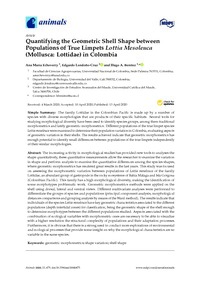Mostrar el registro sencillo de la publicación
Quantifying the geometric shell shape between populations of true limpets lottia mesoleuca (mollusca: lottidae) in Colombia
| dc.contributor.author | Echeverry, Ana María | |
| dc.contributor.author | Londoño-Cruz, Edgardo | |
| dc.contributor.author | Benítez, Hugo A. | |
| dc.date.accessioned | 2020-10-26T21:11:46Z | |
| dc.date.available | 2020-10-26T21:11:46Z | |
| dc.date.issued | 2020 | |
| dc.identifier.uri | http://repositorio.ucm.cl/handle/ucm/3127 | |
| dc.description.abstract | The increasing activity in morphological studies has provided new tools to analyses the shape quantitatively, these quantitative measurements allow the researcher to examine the variation in shape and perform analysis to examine the quantitative differences among the species shapes, where geometric morphometrics has rendered great results in the last years. This study was focused on assessing the morphometric variation between populations of Lottia mesoleuca of the family Lottidae, an abundant group of gastropods in the rocky ecosystems of Bahía Málaga and Isla Gorgona (Colombian Pacific). This family has a high morphological diversity, making the identification of some morphotypes problematic work. Geometric morphometrics methods were applied on the shell using dorsal, lateral and ventral views. Different multivariate analyses were performed to differentiate the groups of species and populations (principal component analysis, morphological distances comparisons and grouping analysis by means of the Ward method). The results indicate that individuals of the species Lottia mesoleuca have key geometric characteristics associated to the different populations (depth intertidal zones) for classification, being the geometric shape of the shell enough to determine morphotypes between the different populations studied. Aspects associated with the combination of ecological variables with morphometric ones are necessary to be able to visualize with a higher resolution the structural complexity of populations and their adaptation processes. Furthermore, it is obvious that there is a strong need to conduct more explorations of environmental and ecological processes that provide some insight on why the morphological characteristics are so variable in the same species. | es_CL |
| dc.language.iso | en | es_CL |
| dc.rights | Atribución-NoComercial-SinDerivadas 3.0 Chile | * |
| dc.rights.uri | http://creativecommons.org/licenses/by-nc-nd/3.0/cl/ | * |
| dc.source | Animals, 10(4), 675 | es_CL |
| dc.subject | Geometric morphometrics | es_CL |
| dc.subject | Shape variation | es_CL |
| dc.subject | Shell shape | es_CL |
| dc.title | Quantifying the geometric shell shape between populations of true limpets lottia mesoleuca (mollusca: lottidae) in Colombia | es_CL |
| dc.type | Article | es_CL |
| dc.ucm.indexacion | Scopus | es_CL |
| dc.ucm.indexacion | Isi | es_CL |
| dc.ucm.doi | doi.org/10.3390/ani10040675 | es_CL |



